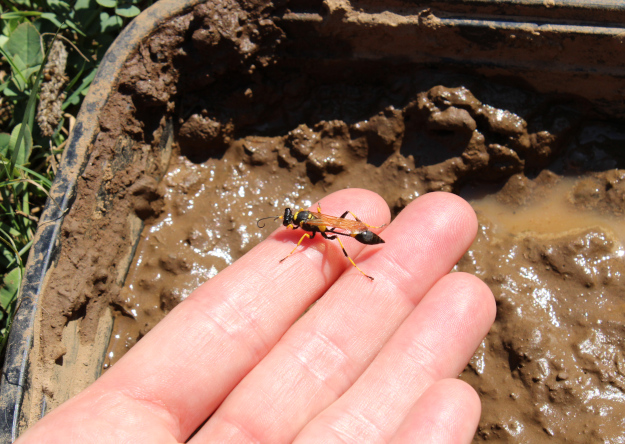
When I began making my garden more wildlife-friendly a couple years ago, I never dreamt that wasps would be among my favorite visitors. I have since gotten a glimpse of the fantastic diversity of wasps that will appear when welcomed into the garden, and I’ve begun to appreciate how beautiful, interesting, and charming they can be. One endearing example showed up last year in late August.
It was a hot, dry summer here in Portland last year (once summer finally kicked in), and while my garden is pretty drought-tolerant, I did have to irrigate it occasionally. The day after one of those waterings, on August 22nd, I spotted a fierce-looking wasp checking out a wet patch of earth near my old rock wall. She was about an inch long. She had a jet-black body splashed with yellow, tawny orange wings, and a long, impossibly thin waist. She was Sceliphron caementarium, a yellow-legged mud dauber wasp, and boy, was she happy to have found some moist earth in this parched land.
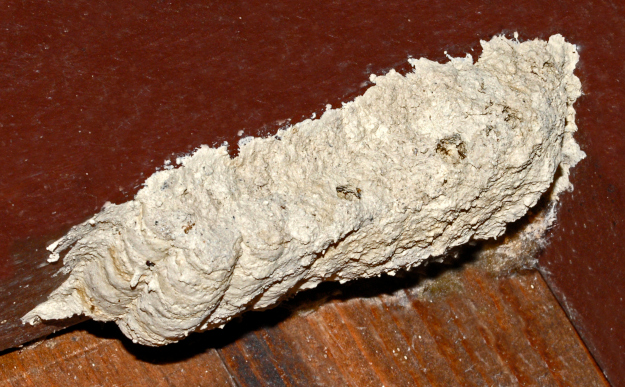
Photo by Hectonichus
The yellow-legged mud dauber is a common species across much of North America. You may have come across its nests under the eaves of buildings or in other sheltered spots. Single mothers build these structures from mud for their offspring; they stuff the cells with several paralyzed spiders and lay an egg on each heap of provisions. At the end of the season, the mother will die, but if all goes well, her offspring will eat the spiders and emerge as adults the following year to mate and repeat the cycle.
My husband named our guest Pam (Pam Dauber), and over the next two weeks, I watched for Pam to return to the mud patch, which I kept moist for her. I saw her at least six more times. I was able to watch her closely with no fear of being stung. Solitary wasps, which make up the vast majority of wasp species we’re likely to encounter, are gentle, and they rarely sting humans. Males have no stinger at all, and females want only to sting their spider and insect prey so they can feed their children. They have no beef with humans.

Pam was an efficient worker. Upon arrival, she would dart around the mud patch, searching for the perfect consistency of soil. Once she’d zeroed in on a spot, she’d put her head down and dig. She emitted a high-pitched, happy hum as she excavated.
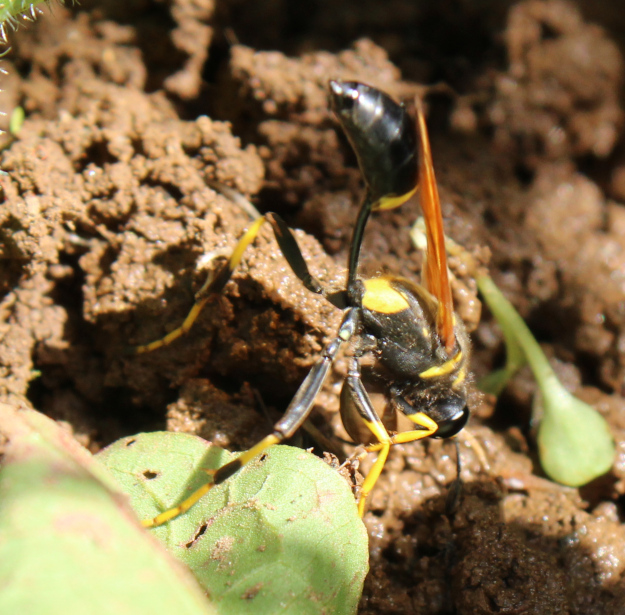
Her body would pitch forward until she was doing a headstand. When she righted herself, I could briefly see the smooth, glistening ball of mud, no bigger than a BB, tucked under her chin and held there with her front legs and mandibles. In a flash, she was off, flying over the house and across the street with her prize. I didn’t know where her nest was, but it couldn’t have been far. One day I timed her, and she took less than two minutes on average to get to the job site, do her masonry, and return for more materials. She worked hard and took few breaks.
In her magnificent book entitled Wasps (Pollination Press: 2021), biologist extraordinaire Heather Holm explains what Pam was probably up to while she was across the street. She likely took up to forty loads of mud to create each cylindrical nursery cell, completing one cell in two hours or less. After building several side-by-side cells and stocking them with eggs and spiders, she probably collected more mud to cover the whole structure and reinforce the walls.
In the mud dauber section of her book, Holm references a very old book on wasps with more information on these fascinating creatures. I downloaded it (it’s so old it’s in the public domain), and I promptly devoured it. George and Elizabeth Peckham published On the Instincts and Habits of the Solitary Wasps in 1898, but the information is still relevant today, and the writing is delightful. The book details the couple’s studies of the life cycles of many groups of solitary wasps on a property in Wisconsin. The idea of a Victorian-era husband-and-wife biologist team geeking out over bugs together is adorable to me. And, man, did they geek out hard. They sat for hours in the hot sun with their eyes glued to wasp nests, they chased the insects through fields, they performed countless experiments, they took copious notes. In the chapter on mud daubers, they report breaking open 573 nursery cells and cataloguing the contents.
One interesting thing the Peckhams emphasize in their book is that even within a species, wasps are individuals, each a little different in their behaviors and abilities. Among mud daubers, they say, this is especially true. They use different sorts of mud in their nests, they vary their architecture, they capture different species of spiders, they make different numbers of cells. They vary in their athleticism and craftsmanship and hunting abilities.
Reading this last winter made me wonder, how did Pam fare in these domains? Was she a good builder? What did her home look like? Was she a good mother? How many babies did she have? How many spiders did she capture? I had seen her hunting one day, but I didn’t get to see her catch anything. Would she manage to shelter her nursery from the winter rains? Would my grainy soil hold up? Would the humans near her nest freak out when they saw it and tear it down out of ignorance and fear?
I thought about that last question a lot.
I could only hope that on one sunny day the following summer, a brand-new black-and-gold wasp with tawny orange wings and an impossibly thin waist would sail into the garden. She’d let me know the kids were all right. Pam’s daughter would be eager to begin home-building and to rear a family of her own, and I’d have to have the mud ready.
I did have the mud ready. This past summer, I converted a Sweet Basil Thai takeout container into a mud-gathering station. I filled it with soil, and every morning I dipped it in my garden pond so the mud would stay moist all day. Having the container near the pond made it easy for me to keep the soil wet. I hoped it would be easy for the wasps to find it there, too, since near a pond is the logical place to look for mud. And I had no doubt that Pam’s daughters would be logical, astute individuals.
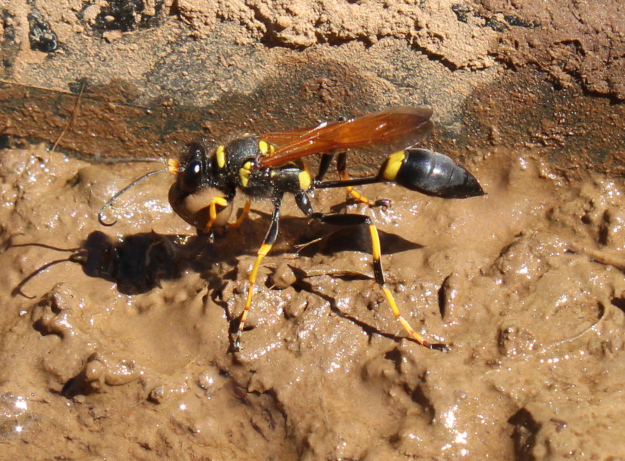
I was not wrong. In late June, Pam’s daughters—or at least, wasps who were the spitting image of Pam—began to appear.

By late July, at least four or five mud daubers visited my takeout tray on a regular basis. On the warmest, sunniest days, it was like LaGuardia in there. Watching the wasps at work became my new summer pastime.

I would often see them sticking around the garden, too, hunting for spiders or sipping nectar from flowers to fuel their busy bodies.
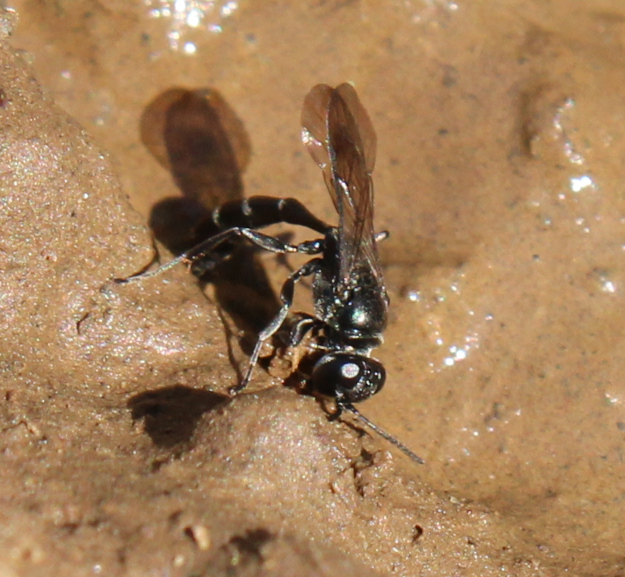
A couple of times I even saw another wasp at the mud tray—Trypoxylon. This is a smaller, all-black wasp that also uses mud in its nest construction and hunts spiders for its offspring.
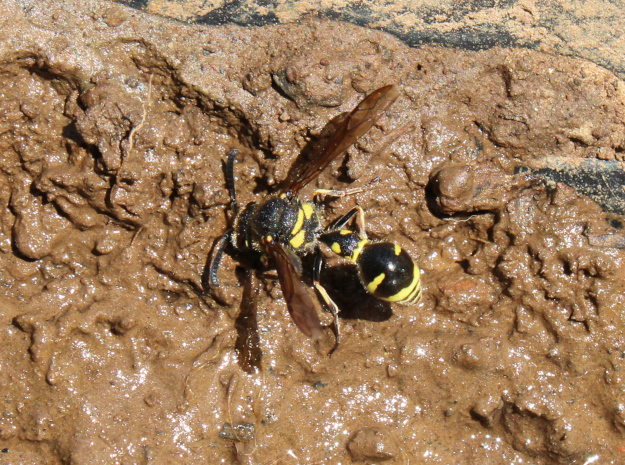
Once, I saw Eumenes use the mud tray, too. I’ve seen these yellow-and-black potter wasps in the garden, hunting for caterpillars, but I’m still waiting to find one of their nests, which look like miniature clay jugs. Next year, I’ll put the mud out in spring for the mason bees to use as well.
Who knew a humble patch of mud could be such a hot commodity in the garden and such a great source of entertainment?

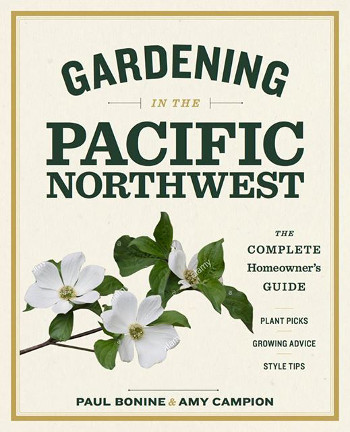























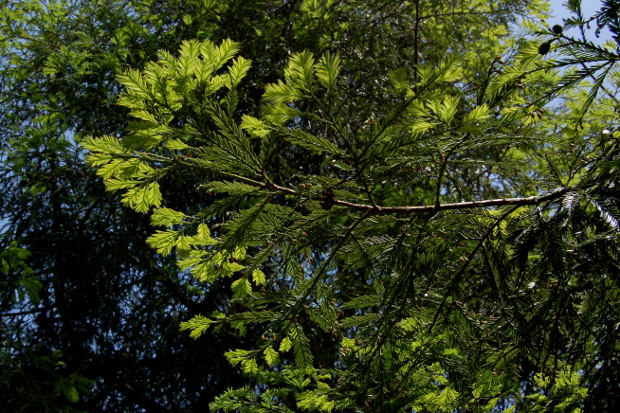


Bring it, Sister. xoxo
Right on! Thanks for reading, Tricia. 🙂
Wonderful reminder for all of us. I’ll follow your example and leave some muddy foraging spots for inhabitants in my neighborhood. For love of pollinators 🐝
Thanks Amy!! 🐝
I’m so happy to hear that, Patti! I hope you get lots of visitors.
Amy,
Wonderful piece on such a beautiful and elegant wasp. You may have already seen this video of rearing and releasing Sceliphron, the mud dauber. You’ve prompted me to set out some mud next spring. Thank you for a wonder article and the patience to get the great photos.
Stephen Morgan
Link: https://www.youtube.com/watch?app=desktop&v=j_xpE35i4sA
Thank you so much, Stephen! I hope you do put some mud out next spring. Please let me know what you see!
Hi Amy,
This is amazing and pure joy to read about the wonder of life that most of us have never observed. Thanks for a terrific read with fabulous images.
Thank you, Barbara! That is so kind of you to say. 🙂
Great post Amy! We had a series of mud dauber’s end up inside the house last summer. I could never quite figure out if they were coming in the back door when I left it open, or thru the bathroom fan which vents to the attic rather than outdoors. I relocated them back outdoors thanks to this handy tool Andrew bought (and that everyone should have) https://carson.com/product/hu-10-bugview-bug-viewer/
My favorite are the potter wasps. I love finding their little jars around the garden.
Oh, I am totally going to get one of those bug viewers! Thanks!
I am so jealous of your potter wasps. Maybe next year I’ll get to see some little clay jars in the garden.